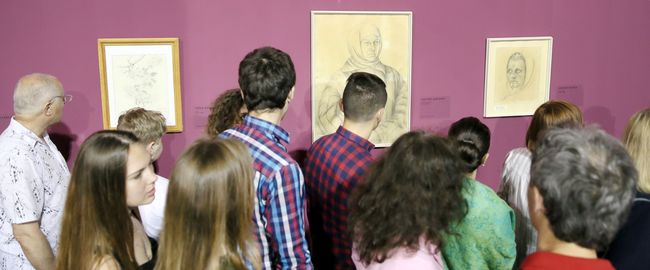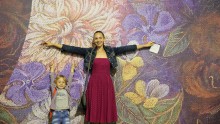“Kateryna Bilokur: I Want to Be an Artist!” is a somewhat pert title of an exhibit to mark the 115th birth anniversary of an outstanding Ukrainian lady. For the first time in history, one project has gathered almost all the oeuvres by Kateryna Bilokur – about 100 artworks from the collections of the Museum of Ukrainian Folk Decorative Art, the Yahotyn Museum of History, and other institutions. Among them are oil paintings, pencil drawings, and watercolors. Next to Bilokur’s pictures are video works by Ukrainian female artists who explain, among other things, whether it is easy for them to defend their right to paint today.
“We tried to make it clear that Kateryna Bilokur is not ‘mothballs,’ not a bronze monument, but a topical artist who fits in with contemporary art,” project curator Alisa Lozhkina confesses. “In my view, the general public does not know Bilokur well. There are people who fanatically love her but are still unaware of this figure’s true caliber.” The exposition is arranged “in the line of ascent” so that the spectator can gradually sink into the atmosphere of Bilokur’s artworks. The first halls show banners with quotations about the mistress, her graphic works, and video works by present-day Ukrainian female artists. The next halls display the artist’s cult oeuvres, mostly oil paintings. It is A Collective Farm Field, a portrait of the artist’s nieces, one of the authors’ own copies of King-Size Ear, and a lot of beautiful, as if freshly cut, flowers.

Photo by Ruslan KANIUKA, The Day
The exhibit reveals the new facets of the legendary mistress. “Bilokur’s artworks have been somewhat ‘moderated.’ A self-taught artist, she was discovered when she was 40, and folk art functionaries tried to persuade her to paint flowers because portraits were ‘not her line.’ As the mistress was forcibly kept in the niche of folk art, she did very few figurative works,” Lozhkina says. “But, judging by the figurative works Bilokur created, she was a ‘crazy’ artist. She showed a kind of pathology mixed with optimism. We can see some joyful works, but each of them has a grain of tragedy. For example, the picture Sleep depicts a baby sleeping in the cradle. Is this picture about a newborn life or death? Maybe, it is Kateryna’s unborn child? A mind-boggling work indeed.”
Many museum people, artists, and ordinary art appraisers visited the exhibit’s opening ceremony. “This unprecedented project helps Ukraine discover what it did not know about itself. There is a stereotype of a flowered Bilokur. But we can see here that she is subtle and refined. Kateryna Bilokur showed a true Ukrainian soul,” Den’s editor-in-chief Larysa Ivshyna said, sharing her impressions of the exhibit.
The project “Kateryna Bilokur: I Want to Be an Artist!” has an educational side. On June 17 Mystetsky Arsenal will hold a class for museum guides and, a week later, a meeting with Olha Samolevska, director of the film Kateryna Bilokur: a Message. An adult evening school of painting, “A Still Life from Life,” will be holding classes every Wednesday. Besides, the exhibit will see the screening of Sergey Parajanov’s film Ukrainian Rhapsody, preceded by a lecture of film critic Oleksandr Teliuk.
The exhibit “Kateryna Bilokur: I Want to Be an Artist!” will remain open at the National Art and Culture Museum Complex “Mystetsky Arsenal” until July 19.







